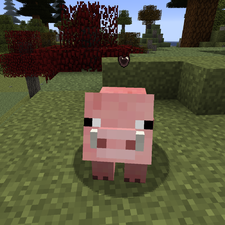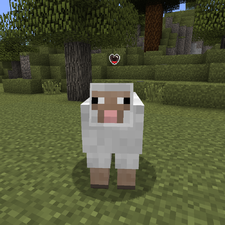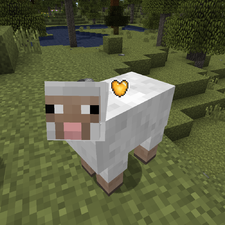Difference between revisions of "Animal Husbandry"
m (→Familiarization) |
(Spawning) |
||
| Line 73: | Line 73: | ||
|} | |} | ||
| − | [[Bear]] | + | [[Bear]]||[[Deer]]||and [[Pheasant]]s are wild, and cannot be bred. Wild animals will respawn and despawn in the world, with the exception of animals that have been named, or [[Rope|roped]] at least once, which won't despawn. |
| + | |||
| + | == Spawning == | ||
| + | Different animals will spawn in the wild based on the [[Region]].<br> | ||
| + | '''Note: Many of these regional animal variants exist in name only at this time and the generic version of the animal is used as a stand-in until the new animals are developed. | ||
| + | ''' | ||
| + | {|class="wikitable" style="text-align:center;" | ||
| + | |- | ||
| + | !Region | ||
| + | !Pigs<br>{{GridImage|Pig}} | ||
| + | !Cattle<br>{{GridImage|Cow}} | ||
| + | !Sheep<br>{{GridImage|Sheep}} | ||
| + | !Bears<br>{{GridImage|Bear}} | ||
| + | !Canines<br>{{GridImage|Wolf}} | ||
| + | !Birds<br>{{GridImage|Pheasant}} | ||
| + | !Deer<br>{{GridImage|Deer}} | ||
| + | !Horses<br>{{GridImage|Horse}} | ||
| + | !Fish | ||
| + | |- | ||
| + | |Americas||Peccary||Bison||Big Horn Sheep||Brown Bear<br>Black Bear||Wolf||||White Tailed Deer<br>Elk<br>Caribou||Wild Horse||Bass<br>Trout<br>Wahoo<br>Pollock | ||
| + | |- | ||
| + | |Europe||Wild Boar||Aurochs<br>Bison||Mouflon||Brown Bear||Wolf||||Caribou<br>Red Deer||Wild Horse||Bass<br>Trout<br>Wahoo<br>Pollock | ||
| + | |- | ||
| + | |Asia||Wild Boar||Aurochs<br>Buffalo<br>Bison||Mouflon||Brown Bear<br>Black Bear||Wolf||Pheasant<br>Chicken||Red Deer<br>Caribou||Wild Horse||Bass<br>Trout<br>Wahoo<br>Pollock | ||
| + | |- | ||
| + | |Africa||Warthog||Buffalo||Mouflon||||Wolf||||Zebra<br>Ass||||Bass<br>Trout<br>Wahoo<br>Pollock | ||
== Familiarization == | == Familiarization == | ||
Revision as of 01:17, 3 July 2020
| This article needs to be updated to match TFC+'s newest version. It might not contain completely accurate information for the newest version. Please help by contributing.
|
Contents
Livestock
Chickens, Cows, Horses, Pigs and Sheep are all livestock. Their wild variants are Jungle Fowl, Aurochs, Wild Horses/Wild Asses, Wild Boars, and Mouflon respectively. Currently only Pigs and Sheep ever domesticate, the rest are always the wild version.
Food
Jungle Fowl, Aurochs, Wild Horses/Wild Asses, and Mouflon/Sheep will follow and accept when sneaking any type of refined grain, as well as maize ears in a similar way that vanilla animals will follow wheat, carrots and seeds.
Wild Boars will follow and accept when sneaking root vegetables and cut brown mushrooms. When domesticated into Pigs they will eat any food (even Cut Red Mushroom which is poison to yourself when uncooked).
Rope also behaves the same way as the vanilla leads in wrangling up livestock.
Pets
Wolves are initially familiarized and claimed through the vanilla method of giving bones until heart particles appear, then they are familiarized further by right-clicking them with an empty hand to pet them daily. After initial familiarization, the animal will recognize the player as its owner and follow it around, but it is not completely obedient, and therefore will not accept commands to sit or stand, and will continue to kill livestock when it is hungry. Disobedient wolves can be forced to sit by tying them to a fence using rope, and forced to stand by tying them to a player. It is important to note however that wolves tied to a fence will still stand up to attack animals that are within close range. Currently, wolves that become angry (growling with red eyes) never calm down. If the fence that the wolf is tied to is broken, the wolf will remain sitting until it gets up to attack something nearby. When a wolf has reached a high enough familiarization level through petting, it will become fully tame and obedient, signified by the addition of a collar.
Food
Wolf food is only used for breeding, and fulfilling the animal's hunger so that it can regenerate health. Wolves will not follow non-owner players who are holding food.
Ownership
Ownership of wolves can be transferred to another player using the command /transfer <username> when the player is near a tamed wolf. If no characters are entered after the command (i.e. /transfer verbatim), the wolf will be set free. Players cannot transfer wolves to themselves, transfer wolves they do not own, or if they have more than one transferrable wolf within range.
Wild Animals
Bear||Deer||and Pheasants are wild, and cannot be bred. Wild animals will respawn and despawn in the world, with the exception of animals that have been named, or roped at least once, which won't despawn.
Spawning
Different animals will spawn in the wild based on the Region.
Note: Many of these regional animal variants exist in name only at this time and the generic version of the animal is used as a stand-in until the new animals are developed.
| Region | Pigs |
Cattle |
Sheep |
Bears |
Canines |
Birds |
Deer |
Horses |
Fish | |||||||||||||||||||||||||||||||||||||||||||||||||||||||||||||||||||||||||||||||||||||||||||||||||||||||||||||||||||||||||||||||||||||||||||||||||||||||||||||||||||||||||||||||||||||||||||||||||||||||||||||||||||||||||||||||||||||||||||||||||||||||||||||||||||||||||||||||||||||||||||||||||||||||||
|---|---|---|---|---|---|---|---|---|---|---|---|---|---|---|---|---|---|---|---|---|---|---|---|---|---|---|---|---|---|---|---|---|---|---|---|---|---|---|---|---|---|---|---|---|---|---|---|---|---|---|---|---|---|---|---|---|---|---|---|---|---|---|---|---|---|---|---|---|---|---|---|---|---|---|---|---|---|---|---|---|---|---|---|---|---|---|---|---|---|---|---|---|---|---|---|---|---|---|---|---|---|---|---|---|---|---|---|---|---|---|---|---|---|---|---|---|---|---|---|---|---|---|---|---|---|---|---|---|---|---|---|---|---|---|---|---|---|---|---|---|---|---|---|---|---|---|---|---|---|---|---|---|---|---|---|---|---|---|---|---|---|---|---|---|---|---|---|---|---|---|---|---|---|---|---|---|---|---|---|---|---|---|---|---|---|---|---|---|---|---|---|---|---|---|---|---|---|---|---|---|---|---|---|---|---|---|---|---|---|---|---|---|---|---|---|---|---|---|---|---|---|---|---|---|---|---|---|---|---|---|---|---|---|---|---|---|---|---|---|---|---|---|---|---|---|---|---|---|---|---|---|---|---|---|---|---|---|---|---|---|---|---|---|---|---|---|---|---|---|---|---|---|---|---|---|---|---|---|---|---|---|---|---|---|---|---|---|---|---|---|---|---|---|---|---|---|---|---|---|---|---|---|---|---|---|---|
| Americas | Peccary | Bison | Big Horn Sheep | Brown Bear Black Bear |
Wolf | White Tailed Deer Elk Caribou |
Wild Horse | Bass Trout Wahoo Pollock | ||||||||||||||||||||||||||||||||||||||||||||||||||||||||||||||||||||||||||||||||||||||||||||||||||||||||||||||||||||||||||||||||||||||||||||||||||||||||||||||||||||||||||||||||||||||||||||||||||||||||||||||||||||||||||||||||||||||||||||||||||||||||||||||||||||||||||||||||||||||||||||||||||||||||||
| Europe | Wild Boar | Aurochs Bison |
Mouflon | Brown Bear | Wolf | Caribou Red Deer |
Wild Horse | Bass Trout Wahoo Pollock | ||||||||||||||||||||||||||||||||||||||||||||||||||||||||||||||||||||||||||||||||||||||||||||||||||||||||||||||||||||||||||||||||||||||||||||||||||||||||||||||||||||||||||||||||||||||||||||||||||||||||||||||||||||||||||||||||||||||||||||||||||||||||||||||||||||||||||||||||||||||||||||||||||||||||||
| Asia | Wild Boar | Aurochs Buffalo Bison |
Mouflon | Brown Bear Black Bear |
Wolf | Pheasant Chicken |
Red Deer Caribou |
Wild Horse | Bass Trout Wahoo Pollock | |||||||||||||||||||||||||||||||||||||||||||||||||||||||||||||||||||||||||||||||||||||||||||||||||||||||||||||||||||||||||||||||||||||||||||||||||||||||||||||||||||||||||||||||||||||||||||||||||||||||||||||||||||||||||||||||||||||||||||||||||||||||||||||||||||||||||||||||||||||||||||||||||||||||||
| Africa | Warthog | Buffalo | Mouflon | Wolf | Zebra Ass |
Bass Trout Wahoo Pollock FamiliarizationAll animals have a familiarity value which needs to be increased in order to interact in certain ways such as milking aurochs, shearing mouflon/sheep, riding horses/asses/mules, breeding animals, and naming animals. The specific values for each of these interactions varies from species to species, with some requiring more work than others. Familiarity can be increased by performing a particular action once every in-game day, resetting at 6 AM (except for milking which resets every 24 in-game hours). For animals that are familiarized through feeding, the player must offer the food while sneaking (Default: ⇧ Shift) as to not spook the animal. If an animal has been familiarized in the last 24 hours, the heart shown above their head will have a pinker background.
Familiarity will decrease slightly each day if it hasn't reached at least 30% and the animal hasn't been interacted with in the past day. Adult animals have a limit of how tame they can become through familiarization, with only baby animals having the ability to become fully domesticated, gaining familiarity much faster than adults. Baby animals retain 50% of their mother’s familiarity when born, unless she is close to maximum familiarity, in which case they will retain 90% of it. Familiarity IndicatorSneaking and looking directly at an animal will display a familiarity indicator. The indicator will fill with red as familiarity increases, turning gold when it has reached either the cap for the adult animal, or 100%. A white border around the indicator means that the animal has reached at least 30%, and that the familiarity will no longer decrease if the animal is not periodically familiarized.
GenderAnimals (excluding squid) have different genders (male or female), which is determined randomly at the time that the animals spawns. Other than bears, horses and wolves, these animals have visual cues to easily determine the gender such as antlers, horns, tusks, udders and different feather colors. For mobs that do not have visual cues, the player can
¹While Bears, Deer, and Pheasants have different genders, they cannot be bred. BreedingAll breedable animals with the exception of jungle fowl are bred by bringing two of the same familiarized animal of opposite genders relatively close together, and feeding both of them until they are full, and heart particles start appearing. The animals will consume 5 ounces of food each time they are fed. If both animals have heart particles, they will move to be close together for a few seconds, before the particles disappear. A successful breeding can be confirmed with a Jungle FowlJungle Fowl are bred through the use of a Nest Box. Hens will lay eggs once a every 1.5 days if there is a nest box, and if there's a rooster within 5 blocks of the nest box the egg will be fertilized. A fertilized egg is noted with a "Fertilized" tool-tip on the item. Removing the fertilized egg from the nest box will remove the fertilized state and it will only be food then.
Pregnancy and BabiesFor all breedable animals other than jungle fowl, the female will become pregnant directly after breeding. Once a female animal has become pregnant, the gestation time must pass before she is able to give birth. Note: This calculation is based on months, not days. So a world with a longer yearLength configuration will result in longer pregnancies, because there are more days in each month. When the pregnancy time is complete, the female will give birth. The gestation time, age until adulthood, and the number of offspring that are born is dependent on the type of animal.
Baby ChicksAfter a fertilized egg has been sitting in a nest box for 3/4th of a month, the egg will hatch into a baby chick. Note: This calculation is based on months, not days. So a world with a longer yearLength configuration will result in longer incubation, because there are more days in each month. Genetic TraitsAll genetic traits are inheritable, and when two animals mate the resulting offspring will have a value for the trait that is an average of the trait of both parents, plus a third randomly chosen value (except for the jump height of bred horses/asses/mules which is currently set at 3.0 blocks). In other words, breeding two animals with a high value for a specific trait will produce babies that have a statistically higher average value, and could possibly be a value that is not found in animals that spawned in the wild naturally. Genetic traits include modifiers for size, strength, aggression and obedience. The size of an animal determines how large the animal actually is, as well as how much meat and the size of the hide that is dropped on death. The obedience and aggression of an animal determines how much familiarity it will gain with each interaction. The aggression and strength of a hostile animal, such as bears and wolves, determines how much damage the animal will deal when attacking other entities. Resources
¹Requires high familiarity. Configuration
History
GallerySee Also
|
||||||||||||||||||||||||||||||||||||||||||||||||||||||||||||||||||||||||||||||||||||||||||||||||||||||||||||||||||||||||||||||||||||||||||||||||||||||||||||||||||||||||||||||||||||||||||||||||||||||||||||||||||||||||||||||||||||||||||||||||||||||||||||||||||||||||||||||||||||||||||||||||||||||||||||


